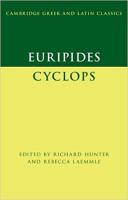
CUP (2020) p/b 268pp £22.99 (ISBN 9781108399999)
It is good to have this Green-and-Yellow edition of Cyclops—the first edition of a Greek play by a Regius Professor (with a colleague in this instance) since the Bacchae of E. R. Dodds some 70 years ago. Indeed, without straining the facts too far, one may add that Dionysus features in both plays, admittedly to a far greater extent in Bacchae. We do not learn how the work was divided between the two editors, but the fact that the Bibliography includes several works by L. in German on satiric drama may afford a clue; otherwise it might be thought perhaps mildly surprising to have a new edition of Cyclops, given the existence of Seaford’s ‘Oxford Red’ edition from 1984, the value of which is acknowledged here (p. ix).
The Introduction is in seven sections. From the first, ‘Euripides’, it is noteworthy that Euripides won first prize at the City Dionysia on only four occasions out of 22 attempts; your reviewer notes that Aristophanes too was relatively unsuccessful: could it be that these two gifted playwrights were too ‘clever’ to appeal to the Athenian audience? In section 2, ‘The Cyclops on Stage’, H/L give an account, from pitiable fragments, of earlier versions, by Aristias, Epicharmus, Cratinus, Callias, with an indirect reference in Wasps via the escape of Philocleon from Bdelycleon: there were also later versions.
Section 3, ‘The Odyssey and the Cyclops’, leads us into difficult territory: was Odysseus giving a ‘true’ account to Alcinous of his adventure with Polyphemus? In one way, the question is meaningless: we have Homer’s account in Odyssey 9, and anything beyond that is ‘outside the drama’, whatever the doubts of (e.g.) Eustathius in about AD 1100. (It would be equally irrelevant to ask whether Holmes ‘really’ disposed of Professor Moriarty at the Reichenbach Falls: Conan Doyle tells us that Holmes so reported [in due course] to Watson: c’est tout.) So ‘Euripides’ Cyclops both bears witness to and was very likely formative for an exegetical tradition which persistently wondered whether Odysseus was telling the truth and how things might “really” have happened, if we had reports which did not emanate from the hero himself’. Thus ‘Cyclops offers a recasting of the Homeric story which amounts in fact to an interpretation, a “critical reading” of it’, and ‘Euripides anticipates later allegorical readings of the Cyclops episode as a clash between reason and the appetites and/or passions’, exemplified, e.g., by Cyclops’ society which wholly lacks wine—very different from Odyssey 9—until Odysseus arrives. Incidentally, is it possible that in this play Euripides takes a sly dig at himself? At 180ff. the Sileni fantasize about the Greek leaders rogering Helen: but surely Euripides would recall that, only 3 or 4 years earlier, his own Helen had posited the heroine as sitting out the Trojan War in Egypt, her place at Troy being taken by a phantom?
Section 4, ‘Cyclops and satyr-play’, well-illustrated by the Pronomos vase (red-figure c. 400 BC) leads H/L to mention E. Hall’s view that ‘satyr play functioned to affirm a group identity founded in homosocial laughter and the libidinal awareness of its male, citizen audience’. However, say H/L, the satyrs of satyr play seem singularly unsuccessful in their pursuit of sex and other satisfactions, and so are not obviously role models for men who need to shed dangerous ‘feminising’ emotions—in fact, quite the opposite, as H/L amply demonstrate. This is further developed in an important paragraph on p. 35 (strongly recommended, but too long to quote): ‘[there is no good reason to imagine that] any particular aspect of the makeup of the audience, such as gender or political ideology, was paramount here’.
Section 5, on ‘Language and Metre’, instances cases of the ‘admission of a more pronounced colloquial or conversational stratum than found in tragedy’; metrically, the trimeters of Odysseus differ little from those of tragedy, though this is not true of the short choral songs, where simplicity rules. In Section 6, H/L examine (at surprising length) the evidence for the date, concluding—as does Seaford—that a date in the latter part of Euripides’ career is indicated: they opt for 408 BC. This is followed by the Text and apparatus criticus (based on Diggle’s OCT edition, though this is not categorically stated): Cyclops is one of the plays of Euripides whose transmission effectively depends on one manuscript, the 14th century Laurentianus (L), corrected by Triclinius, the 14thcentury scholar from Thessaloniki.
The publishers suggest that this edition will be suitable for ‘advanced undergraduates and graduate students’, as well as for ‘scholars’. Your reviewer is conscious of a sense of lèse-majesté in noticing this commentary from a Regius Professor, but his sampling gives him confidence that the publishers’ aim has been fully achieved. However, I noticed a dozen or more cases where it had been found necessary to explain the forms or uses of verbs with which one might have expected familiarity: which tells its own story concerning the level of knowledge (or lack of it) of grammar that nowadays has to be accepted. Cyclops contains only a moderate amount of indecency, but I seemed to detect a less-than-Dover-like bluntness on those occasions where it is to be found (not that clarity is lost thereby): for further comment on indecency (especially doubles entendres) in Cyclops, see Henderson The Maculate Muse (1991), p.27: E. Hall’s positing at 182-4 of a sexual pun is, however, ‘unproved and unnecessary’. I noticed only one (insignificant) typo.
Our gratitude is due to the editors: there will surely be no need for a further commentary on this play for many years
Colin Leach
